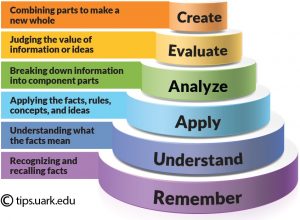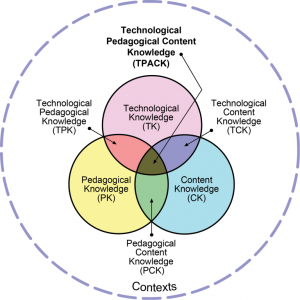Using technology in the classroom is what many teachers have incorporated as part of their craft. With the ever changing landscape of software tools and applications, it creates an exciting atmosphere of the possibilities that one can accomplish in the classroom. Incorporating technology has always brought me back to the thoughts of Bloom’s Taxonomy, and how to scaffold towards higher level thinking for learners.
Image courtesy of Jessica Shabatura
I find models have merit in creating a framework for my own pedagogical practice, but feel it is dependent on the practitioner as to which model is the best fit. I feel the SAMR model is dependent on one being a master teacher, whereas the TPACK model is more inclusive towards helping the practitioner understand the multi-faceted relationships that are required to implement technology.
Thoughts on the SAMR Model
Dr. Ruben Puentedura developed a framework for incorporating technology in which one progresses towards greater incorporation and complexity with the use of technology by the following strategy:
- Substitution
- Augmentation
- Modification
- Redefinition
In his model Dr. Ruben Puentedura identifies when technology changes from enhancing to transforming the classroom environment. The model sets a framework for an individual to identify and reflect on their own practices where they are in the model.
What the model doesn’t reflect is the instructional design process. In The SAMR Model as a Framework for Evaluating mLearning article, the authors suggest that when developing a unit with the SAMR model you must consider the instructional design process taking into account technical, pedagogical, and management issues.
In a critical review of the SAMR model, authors Erica R. Hamilton, Joshua M. Rosenberg, and Mete Akcaoglu suggest the SAMR model could be more context sensitive, add more layers to the complexity of the various relationships involved with learning, and address instructional design. The authors also highlighted the lack of peer review to analyze the model and various perceptions readers have in the implementation of the model.
The TPACK Model
The Technological Pedagogical Content Knowledge Model provides a multi-dimensional view of learning the SAMR model lacks. The presentation by the authors illustrating a Venn Diagram with Technological, Pedagogical, and Content knowledge surrounded by contexts allows the reader to identify the complexity of including technology in a successful way.
The pertinence between Pedagogical Knowledge (PK) and Content Knowledge (CK) is the most crucial element to master, and what I feel many teachers (including myself) strive for to consider themselves a master teacher and leader. The TPACK model creates a foundational footprint towards being 21st century expert teacher; a person who creates their own path for encapsulating technology into the deeper core of learning in a successful way.
Conclusion
I appreciate how the SAMR model scaffolds technology from a form of enhancement to a transformative element, as it is a useful concept when being mindful of creating new units and lesson plans when teaching. The SAMR model feels more substantial if you layer in Bloom’s Taxonomy as to how you can apply technology into bridging learning communities together. The SAMR model on its own has challenges when addressing pedagogical practice for the practitioner. It is my opinion that an instructor with a strong background in curriculum design and pedagogy could connect the dots in layering the SAMR model with their own prior knowledge.
I feel the TPACK model is overall a more holistic view of education that provides the big picture. It can be more useful than the SAMR model with highlighting how one can grow in their own professional development in their knowledge base. It can allow one to reflect from all 3 spheres and connect towards the interlocking relationships in moving forwards towards incorporating technology effectively.


Recent Comments